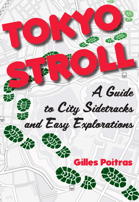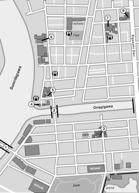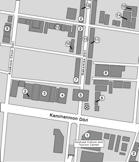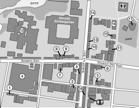











Tokyo Stroll Supplement: Tsukiji

This page indexes, contains corrections and has additions to the Tsukiji chapter of Tokyo Stroll.
For information on Tokyo Stroll and this web supplement see Tokyo Stroll Supplement home page
For users of the Organic Maps, Maps.Me and Google Maps apps the items below have bookmarks you can import into those apps to make navigation easier.
Instructions and links are on the Viewing Locations in Organic Maps, Maps.Me, Google Maps, or Google Earth page.
Some entries on this page may include a note that says "Description to be added soon ." These entries are for items I felt should be listed even if the description is not ready to assist those who wish to plan a trip. When possible I included a link to an official web page, I suggest also doing web searchs for more information.
This park has a grove of Metasequoia, or dawn redwood, it also has a bust of Philipp Franz von Seibold near the fountain. Seibold helped spread Western medical knowledge to Japan during the rule of the shoguns. The bust was a gift of the Stichting Isaac Alfred Ailion, a foundation of Leiden University to Chūō-ku with assistance from the Asahi Shimbun newspaper. His Japan born daughter Ine would later go to medical school, play a role in spreading Western knowledge, and practice medicine for several years. Next to the park is Saint Luke's Hospital, one of the first Western hospitals in Japan.
NEAREST TRAIN/SUBWAY STATION: Tsukiji Station (Tokyo Metro Hibiya Line)
Asahi Shimbun Head Office (朝日新聞): Tokyo Stroll, Tsukiji Chapter, page 399
NEAREST TRAIN/SUBWAY STATION: Tsukijishijō Station (Toei Ōedo Line)
Hamarikyū Gardens / Hamarikyū Onshi Teien (離宮恩賜庭園): Tokyo Stroll, Tsukiji Chapter, page 399
NEAREST TRAIN/SUBWAY STATION: Tsukijishijō Station (Toei Ōedo Line)
Kachidoki Bridge Museum / Kachidokibashi no Shiryōkan (勝鬨橋の資料館): Tokyo Stroll, Tsukiji Chapter, page 398
NEAREST TRAIN/SUBWAY STATION: Tsukiji Station (Tokyo Metro Hibiya Line), Tsukijishijō Station (Toei Ōedo Line)
Kachidokibashi (勝鬨橋): Tokyo Stroll, Tsukiji Chapter, page 397–398
NEAREST TRAIN/SUBWAY STATION: Tsukiji Station (Tokyo Metro Hibiya Line), Tsukijishijō Station (Toei Ōedo Line)
Namiyoke Inari Shrine / Namiyoke Inari Jinja (波除稲荷神社): Tokyo Stroll, Tsukiji Chapter, page 398
NEAREST TRAIN/SUBWAY STATION: Tsukiji Station (Tokyo Metro Hibiya Line), Tsukijishijō Station (Toei Ōedo Line)
St Luke's Tower (聖路加タワー)
Built in 1994 these buildings are part of the St. Luke's Life Science Centre, which also includes the nearby St. Luke's Hospital. There are two towers, avoid the shorter one as it is residences, the taller is mainly offices with some shops and restaurants. There is also a great view from the observation deck. To access the deck take the elevators to the 46th floor and after that take the stairs that are marked to access the 47th floor and enjoy a great view over the Sumidagawa.
NEAREST TRAIN/SUBWAY STATION: Tsukiji Station (Tokyo Metro Hibiya Line)
WEB: http://www.sltowers.co.jp
This small Shinto shrine is for Suijin a kami associated with water, the term Suijin is not really an individual name and can be applied to any of several water associated deities. The shrine is also known as Suijin-sama and Uogashisui Shrine This particular shrine is actually a branch of a larger one at Kanda Myōjin. Rather than being a neighborhood shrine it is the shrine for the fish market itself. On the 5th of every month priests from Kanda Myōjin come here to perform rituals. The shrine festival, Uogashi Suijin-sai, has a mikoshi parade that is very energetic. At one time the kami took control of the mikoshi and headed towards the Ginza only to be stopped by the police who confiscated the carrying poles for the rest of the day to prevent further traffic violations. Once every generation they hold a major festival, the last three were in 1920, 1955, and 1990. Nothing seems to stop this festival as the 1990 one had been held during a typhoon.
NEAREST TRAIN/SUBWAY STATION: Tsukijishijō Station (Toei Ōedo Line)
NOTE: I need to do further verification regarding the shrine. It is visible in recent satelite views, but some web sites claim it was moved to the new Toyosu Fish Market. There is no reason for there to not be two shrines.
Founded in 1617 near Asakusa as a branch of the Nishi Hoganji in Kyoto. When that temple was destroyed in the Meireki Fire in 1657 it was moved to present site. The relocation was carried out with a great deal of assistance from the fishermen of Tsukudajima who's families had and still maintain close ties with the temple. After the Great Kantō Earthquake in 1923 and fire a decision was made to build it out of stone. The present building was completed in 1934 and designed by Chūta Itō who was also influential on preserving old temples and shrines. The exterior of the design is heavily influenced by Indian temples and made of granite. The interior is more Japanese with the modern inclusion of Western style seating and a pipe organ. Visitors are welcome to wander about inside, if you do so be quiet and not use a flash, or even take pictures, as this is a place of worship. However don't be nervous as the temple is actually welcoming to outsiders.
This temple was recognized as a tangible cultural asset of Japan in 2011.
The main entrance is to the North-West.
Daily services are at 7 am and 4 pm, the English service is the 4th Saturday of the month at 5:30 pm. There is a lunchtime pipe organ concert on the last Friday of the month at 12:20 pm. On the Sunday closest to April 8 there is a fair in the spacious compound.
NEAREST TRAIN/SUBWAY STATION: Tsukiji Station (Tokyo Metro Hibiya Line)
WEB: http://www.tsukijihongwanji.jp/eng/
Tsukiji Outer Market / Tsukiji Jōgai Ichiba (築地場外市場): Tokyo Stroll, Tsukiji Chapter, page 399
NEAREST TRAIN/SUBWAY STATION: Tsukiji Station (Tokyo Metro Hibiya Line), Tsukijishijō Station (Toei Ōedo Line)
Back to the Tokyo Stroll Supplement home page - Privacy Notice - Back to Gilles' home page
Created July 10, 2019 | Content last updated June 28, 2025